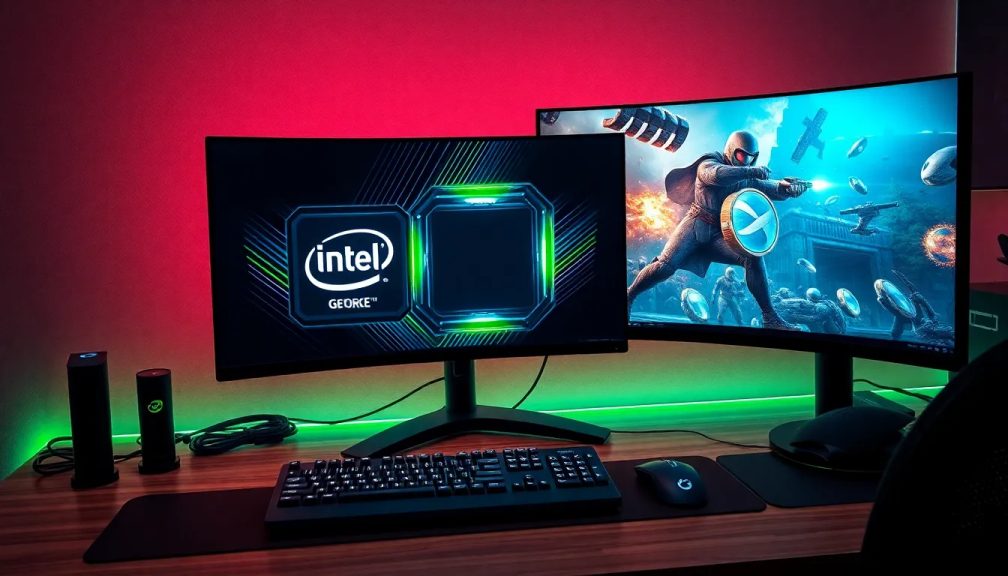Intel gaming CPUs to include integrated Nvidia GeForce RTX GPUs

In a groundbreaking announcement, Intel and Nvidia have revealed a collaborative effort that promises to revolutionize the landscape of personal computing. The two technology giants are set to develop Intel CPUs that will feature integrated Nvidia GeForce RTX GPUs. This partnership is not limited to artificial intelligence or data centers; it specifically targets the personal computer market, raising significant interest among gamers and tech enthusiasts alike.
The implications of this collaboration are profound, especially considering the current competitive dynamics in the CPU and GPU markets. With AMD dominating the x86 CPU scene thanks to its integrated GPU solutions, the introduction of these new Intel chips could shift the balance of power in the industry. Let's explore the details of this partnership and its potential impact on computing.
What are the key features of the Intel and Nvidia collaboration?
The partnership aims to produce a new type of system-on-chip (SoC) that integrates Nvidia's RTX GPU chiplets directly into Intel's x86 CPUs. This innovative approach stands to improve performance and efficiency in personal computing devices.
- Integration of Technologies: The new SoCs will combine world-class CPUs and GPUs, optimizing performance for demanding applications.
- Chiplet Design: Instead of relying on monolithic silicon chips, Intel will employ a chiplet architecture, allowing for more flexibility in design and manufacturing.
- Enhanced AI Capabilities: With access to Nvidia's AI technologies, Intel CPUs may significantly improve in processing capabilities, especially in tasks requiring deep learning.
- Support for DLSS: Future Intel CPUs could potentially run Nvidia's Deep Learning Super Sampling (DLSS) technology without the need for an additional graphics card.
How does this impact AMD's position in the market?
AMD has long held a commanding position in the x86 CPU market, particularly with its chips being utilized in both current-generation gaming consoles and handheld devices. The collaboration between Intel and Nvidia poses a direct challenge to AMD's supremacy.
This is especially critical given that AMD's integrated GPUs have been seen as a go-to solution for gamers seeking cost-effective performance. The emergence of Intel's integrated Nvidia GPUs could lead to:
- Increased Competition: Intel's foray into integrated GPUs may compel AMD to innovate further in its offerings.
- Market Share Shifts: Consumers may begin to favor the new Intel chips, potentially eroding AMD's market share in both consumer and enterprise markets.
- Price Adjustments: AMD may need to reconsider its pricing strategies to remain competitive against Intel's new offerings.
What is the significance of integrated GPUs in personal computing?
Integrated GPUs within CPUs have become increasingly important for several reasons:
- Cost Efficiency: Users can save money by not needing a separate, dedicated graphics card.
- Space Saving: Integrated solutions take up less physical space, making them ideal for compact builds.
- Power Consumption: Integrated GPUs typically consume less power than discrete cards, which is crucial for laptops and portable devices.
Will this collaboration affect future Intel CPUs?
Intel has ambitious plans for its upcoming CPU generations, including the much-anticipated 15th generation. With the integration of Nvidia's GPU technology, future Intel CPUs are expected to deliver superior performance, particularly in gaming and AI-driven applications.
Intel's Arrow Lake CPUs, which are slated to release in the near future, are likely to benefit from this partnership. The integration of Nvidia's Tensor cores may enhance the overall processing capability, making these CPUs a formidable option for gamers and professionals alike. As stated by Intel and Nvidia:
"These new x86 RTX SOCs will power a wide range of PCs that demand integration of world-class CPUs and GPUs."
What can we expect from future announcements?
As Intel and Nvidia prepare for a webcast press conference, expectations are high for further details regarding their collaboration. Industry insiders anticipate that the companies will reveal:
- Specific Architectures: Insights into the chip designs and how they will function in real-world applications.
- Target Markets: Clarification on whether these chips will be primarily aimed at laptops, desktops, or both.
- Performance Benchmarks: Initial performance metrics that could showcase the power of the new integrated solutions.
In this context, Nvidia CEO Jensen Huang has described the partnership as a "historic collaboration," indicating the potential for a new era in computing. As the two companies work to expand their ecosystems, the landscape for both gamers and developers could change dramatically.
As this story unfolds, reactions from the community will likely vary. Will this partnership be a game-changer in the CPU market? Join the conversation on our Discord server and share your thoughts!
For those looking to get an early peek at what this collaboration may yield, check out this insightful video discussing the implications of the Intel and Nvidia partnership:




Leave a Reply